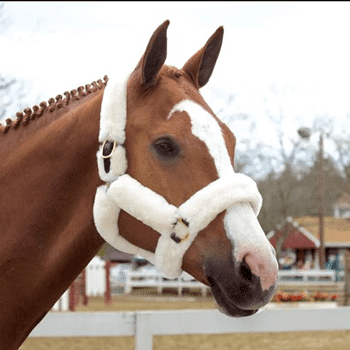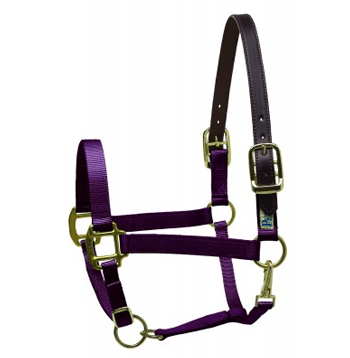Haltering for Safety – A How to Guide
It was a regular evening when Debbie went to her barn to spend time with her thoroughbred mare. Horse and owner were both relaxed and calm while they enjoyed a routine grooming session. Her mare, Royal, was wearing a nylon halter with a lead line tied tightly to a short wooden beam inside the old barn.
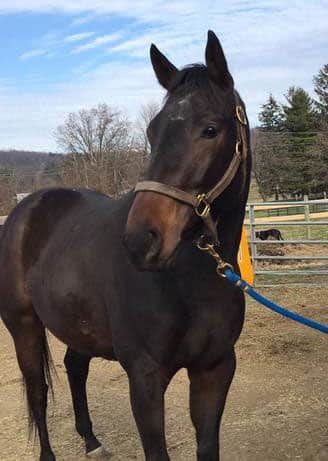 But things changed in an instant when the wasp landed on her horse’s flank and stung.
But things changed in an instant when the wasp landed on her horse’s flank and stung.
The horse reared back in surprised and quickly felt restraint from the unbreakable nylon halter. Debbie also jumped back in alarm unable to quickly grab the safety release knot where her horse was tied. The mare continued to pull in panic with her hooves scrambling against the hard dirt floor. After several seconds of struggle, the old beam ripped free from its structure.
Then the horse was off. She bolted out of the barn in pure terror as the wooden beam trailed along behind her. It took weeks of retraining to help the animal recover from her experience.
Stories like this illustrate the importance of safe haltering practices. Yes, you want a halter that will look great and stay strong, but you also want one that will help your horse avoid serious injury and trauma.
The right type of halter is even more important when it comes to your horse trailer. In this article, we’re going to take a look at some of the common types of horse halters available. We’ll break down the pros and cons so you can choose the right style for your horse.
Common Types of Horse Halters
When it comes to halters, there are a wide variety of types and styles. Some of them look fantastic, are incredibly strong, and cost a pretty penny. Some are specifically designed to breakaway for safety. Then, others, are specially made to help train your horse to behave.
Knowing your horse and knowing the situation you’re in will help you determine which style of halter is suitable and when.
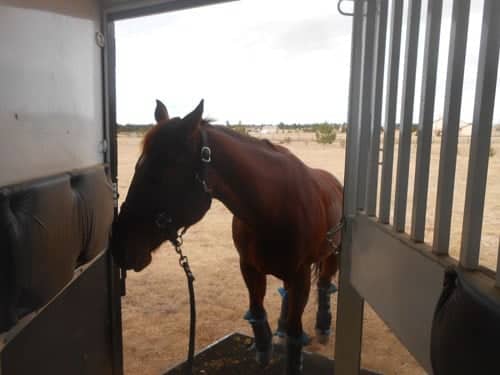 Leather Halters – The original breakaway halters, leather halters are the safest standard type for your traveling horse. Although it can be more expensive and will require regular care, the material can break in case of an emergency. A leather halter made of English bridle leather will cost more than one made of American cowhide. Halters with triple ply construction, triple stitching along the cheek pieces or curved throatlatches will also cost more but be of higher quality.
Leather Halters – The original breakaway halters, leather halters are the safest standard type for your traveling horse. Although it can be more expensive and will require regular care, the material can break in case of an emergency. A leather halter made of English bridle leather will cost more than one made of American cowhide. Halters with triple ply construction, triple stitching along the cheek pieces or curved throatlatches will also cost more but be of higher quality.
Nylon Halters – Nylon halters are tough, durable and reliable -- and those are just three reasons why you shouldn’t haul with them. They’re considered basically unbreakable by horses, meaning that your horse will be in big trouble if he finds himself in a trailer that has turned over. Nylon halters are often described as either “nylon web” or “polypropylene.” A nylon web halter is stronger and can stand up to rough use. However, it’s incredible strong. Polypropylene is a weaker material and is also usually less expensive. It does not absorb as much water as nylon webbing.
Shipping Halters – Many horse people have noticed rubs on their horse’s face after long hours spent in the trailer. To combat this, shipping halters will line the halter with soft natural sheepskin or sewn on fleece lining. It looks really fancy, but this type of halter is hard to keep clean. So, you would only use this type of halter during shipping to prevent rubs. Pay attention to whether your new shipping halter is made of leather or a synthetic material. (Photo Below)
Breakaway or Safety Halters – In general, leather is more likely to break than a synthetic material. That’s why many breakaway or safety halters will often have a synthetic face with a leather crown piece. They may also have a synthetic crown with a tiny leather flap to act as a break point right before the ring. This way, if the horse pulls back, the leather will allow a horse to get free. (Image below)
Rope Halters – Rope halters are a rustic style where a single piece of thin rope is formed into a halter. They make great training tools because the thin rope allows you to exert pressure on your horse’s face. They are usually made of polypropylene. Since they do not have any metal hooks, this type of halter would not be safe for trailering as it would take a great amount of force to break.
Grooming Halters – This is a very loosely fitting halter with a very simple design. It just consists of a noseband and a crown piece. Use this halter with a well-mannered horse only when you want extra access to their face for grooming.
Training Halters – When you are teaching your horse to yield to a lead-line, it helps to have a training halter. That’s because the strategically placed straps put pressure on your horse’s head so you have extra control. It’s a useful training tool to help your horse learn to walk obediently by your side.
Foal Halters – Foals are adorable, but they are also fast-growing and rambunctious! A foal halter is designed so it can be easily adjusted as the horse grows. Plus, it lets a handler begin training the foal for good ground manners.
Combination Halter/Bridles – Do you love trail riding? If so, a combination halter / bridle may be the perfect solution. It has easy-to-install cheek straps and a bit to quickly transform your halter into a bridle for fun days on the trail.
Show Halters – A show halter is designed to make your horse look fantastic and give you control of your animal while in the show ring. They are made of high quality materials and often adorned with beautiful decorations. You could easily spend several hundred dollars on a fancy show halter.
More Safety Measures to Protect Your Horse While Trailering
After you’ve chosen the right type of halter for your trailer ride, it’s time to pay attention to other safety practices. Many trailers come with welded metal loops for tying your horse inside the trailer. You may consider installing emergency breakaway trailer ties or even a simple loop of baling twine to add a breakaway element to your trailer tie set up.
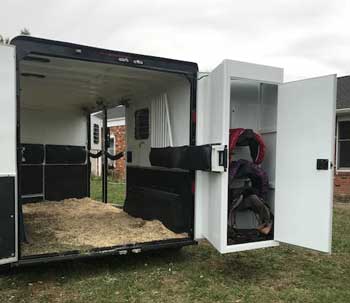
If you are using a straight load horse trailer, look for butt and chest bars with a safety release pin. This way, the bar can be lowered even with the full weight of the horse on top of the bar.
Interior trailer dividers should be made of a strong material that can be disassembled in case of an emergency. Stay away from weak metals like aluminum as they can twist and tear in an accident. Our Z-frame dividers are a much stronger and safer option.
Most importantly, train your horse to load and offload from a trailer safely and calmly. We should always be prepared for a serious roadway accident, but a great majority of horse owners experience problems simply by trying to load or unload their horse for a regular trip through town.
A trailer with a walk-on-walk-off configuration will allow you to walk your horse on the trailer and then straight off without ever having to back up. Our patented SafeTack horse trailer also eliminates the very dangerous narrow loading door found on most slant load trailers. Instead, the rear tack area swings out like a second door allowing for a wide open entry point for the horse and their handler.
Nobody wants to think about getting into an accident with their horse in the trailer behind them, but it can and does happen much more frequently than we’d all like to admit. When you’re hauling, it’s the little things, like using the right halter that makes the difference between a horse that walks away from a trailer turnover and one that doesn’t.
If you have any questions about the content of this article or about building a custom horse trailer with Double D Trailers, drop us a note! Owner Brad Heath would be happy to help you get started designing your very own custom horse trailer.

